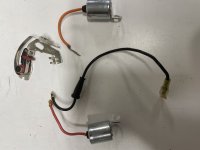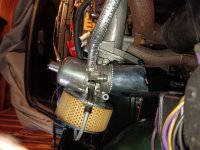RJS
Jedi Warrior
Offline
Wow, talk about frustrating. I had a similarly hard to diagnose issue 6 years ago. Started has a misfire only when hot and under heavy load. Progressively got worse over several months where it misfired when hot, then warm, then all the time. Finally died and left me stranded one mile from home.
Not sure how but finally diagnosed it as a failure of the low tension lead from coil to dizzy (no. 52 in Moss catalogue). Vibration had caused the strands of wire at the female connector to slowly but surely fail. Heat apparently exacerbated the problem.
$-0- repair once diagnosed. Cut off old connector, crimped on new one. Soldered it and used heat shrink tubing to give it some structural integrity.
If this is your issue, I bet when replacing cap, points, condenser yesterday you unknowingly moved the wire temporarily restoring integrity to the connection.
Easy to check and rule out. Even more frustrating if all this was due to a $1.89 piece of wire.
Good luck
Bob
Not sure how but finally diagnosed it as a failure of the low tension lead from coil to dizzy (no. 52 in Moss catalogue). Vibration had caused the strands of wire at the female connector to slowly but surely fail. Heat apparently exacerbated the problem.
$-0- repair once diagnosed. Cut off old connector, crimped on new one. Soldered it and used heat shrink tubing to give it some structural integrity.
If this is your issue, I bet when replacing cap, points, condenser yesterday you unknowingly moved the wire temporarily restoring integrity to the connection.
Easy to check and rule out. Even more frustrating if all this was due to a $1.89 piece of wire.
Good luck
Bob
This evening I just about gave up on this car. No matter what I tried, the car wouldn’t start and the spark seemed unusually weak using the old “screwdriver 1/4 inch from ground” method.
I decided to stop in at the local Moss dealer and shop, and I bought a new distributor cap, points and condenser. The engine started right up and runs perfectly now.
This is so frustrating because I put new points and condenser in just a little over a month ago, and I have two old distributor caps that I switched out and none of them made any difference.
I can’t quite even begin to figure out the problem, but I have a few suspicions.
One suspicion is that there are manufacture defects in the distributor caps, and that I finally have one that is correct. Another is that condensers are regularly defective, new or not, but I can’t imagine that a bad condenser would cause me to stall and then also prevent me even from restarting the vehicle. My third suspicion is one I’m actually considering seriously.
It’s this: My Moss Cobalt brand plug wires look great, but fit very tight, and I often have trouble feeling the snap at the back of the spark plug. I’m wondering if this intermittent problem I’m having with my engine stalling, and then not starting, is caused by a plug wire slipping off the spark plug inside the boot.
In any event, as far as I’m concerned, the mystery continues despite my presently perfectly running engine.

 Hi Guest!
Hi Guest!

 smilie in place of the real @
smilie in place of the real @
 Pretty Please - add it to our Events forum(s) and add to the calendar! >>
Pretty Please - add it to our Events forum(s) and add to the calendar! >> 



